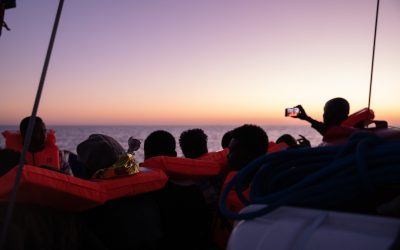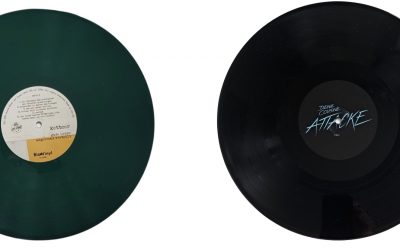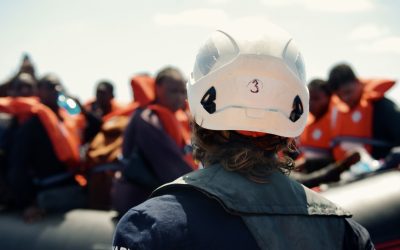The lack of understanding and the anger about how something like this can happen in one of the most heavily monitored sea areas accompanied us as we made our way to the operational area in the central Mediterranean. We were more motivated than ever – motivated to support people in distress, motivated to make a difference.
At noon on August 16, the crew of the NADIR was contacted by the reconnaissance aircraft Seabird 2. Our allies from Sea-Watch alerted us to people on a fiberglass boat in distress. Deep in the Maltese SAR zone, north of Sabratha in Libya and east of Sfax in Tunisia.
It quickly became clear that we were not the only ones searching for the boat. But we were the only ones with humanitarian intentions. The so-called Libyan “Coast Guard” was also approaching the presumed location, but with the goal of carrying out an illegal pullback to return people to a country in civil war-like conditions, where imprisonment, coerced labour, physical violence and torture would await them.
When we reached the twelve people aboard the small boat, their vessel was drifting with a broken engine in high waves. We quickly distributed life jackets and stabilized the situation. How narrowly we arrived before the Libyan militias on scene became clear when, just minutes later, one of their fast grey boats approached within a few hundred meters. Panic arose among the survivors, but subsided once we reassured them that we did not cooperate with Libyan actors.
A short while later, the reconnaissance plane still circling above us alerted us about another Libyan vessel speeding toward our position, which we soon spotted on the horizon ourselves. We weighed the situation for tense minutes, until it resolved itself when the pursuers unexpectedly turned back. It remains unclear what ultimately caused the militia ship to retreat, but when we later learned about the OCEAN VIKING being fired upon by the so-called Libyan Coat Guard, we were retrospectively relieved that we had avoided a close-range confrontation.
After providing water, food, and seasickness medication, NADIR accompanied the fiberglass toward Lampedusa, the closest safe port, about 70 nautical miles away. To ensure the people’s safety during both day and night, our tender remained constantly in use. In the darkness, about one nautical mile within Italian territorial waters, the people were finally able to safely transfer to an Italian Coast Guard vessel. To personally deliver the situation report to Italian authorities, the NADIR and her crew then also were ordered to Lampedusa.
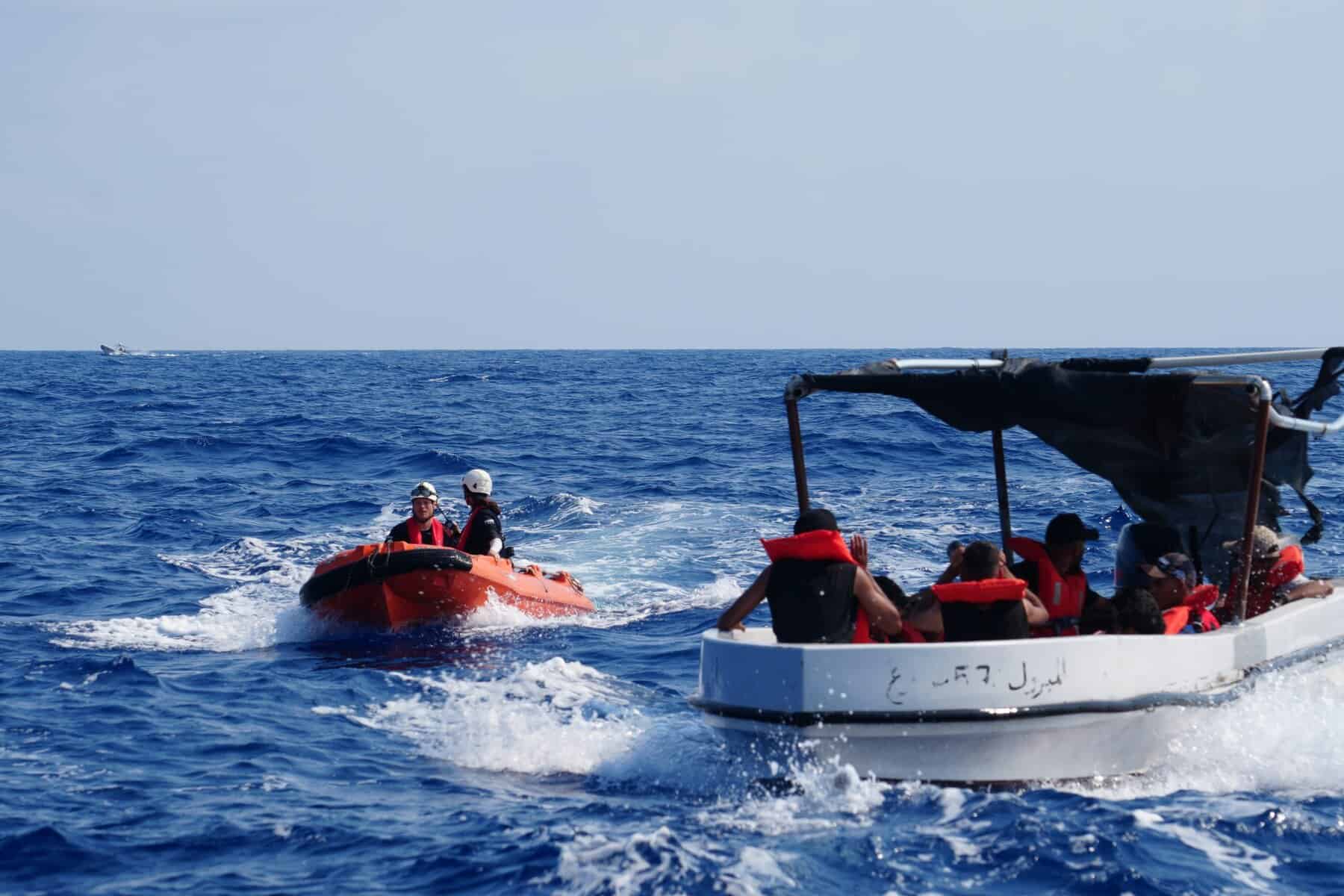
FOR THREE SISTERS, HELP CAME TOO LATE
The next morning, the crew of the NADIR once again set course for the operational area. The following days at sea were marked by rough conditions. An uneasy cross sea with high waves combined with an ominous silence. Only few distress alerts reached us, but all too far out of NADIR’s reach. The vastness of the Mediterranean became strikingly clear.
On Friday, 22 August, 2025, the growing silence was broken by a distress call from the organization Alarm Phone – Watch the Med. 50 people were in distress on a green rubber boat just outside the Libyan SAR zone, among them women and many children. The situation was critical. We set course for the last known position.
At dusk, our search began that lasted for hours and only ended at 2 a.m. In the light of the moon and two flames from a distant oil platform, we tried to spot signs of the rubber boat in distress. Equipped with searchlights and binoculars, we searched for the proverbial needle in a haystack. The longer the search lasted, the greater our fear of not finding the people grew. Finally, we spotted a faint light on the horizon, seemingly signalling to us.
As we drew closer, the smell of gasoline grew stronger. We suddenly heard screams. Of men. Of women. And of children. Soon we saw it with our own eyes: the utterly overcrowded, helplessly rocking green rubber boat. It was immediately clear that we had to act – and we had to act fast.
The rubber boat had left Zuwara, Libya, the previous day with 72 people. Only hours after departure, it began taking on water. Attempts to bail it out failed, and many had to endure kneeling in a corrosive mix of seawater and spilled gasoline. Among them were numerous women, three of them pregnant, several children, and even a seven-month-old baby. Under extremely difficult conditions, we carried out the procedures we had trained for many times: explaining the rescue steps in several languages, giving everyone life jackets, prioritizing the evacuation of babies and small children with our tender, and finally transferring all passengers from the rubber boat to the NADIR.
During the final stage of the evacuation, sudden cries broke the already calmed situation. Someone pointed to the rubber boat, now two-thirds evacuated. People were under the water’s surface inside the rubber boat. A tragedy was unfolding. In the darkness, with high waves, water entering the overcrowded rubber boat, and panic spreading, three children had drowned unnoticed. Shock spread among the survivors as the realization set in. Our medical team tried in vain to resuscitate the girls.. For the three sisters, aged nine, eleven, and seventeen, help came far too late. They had already been dead for too long. Survivors additionally reported that another person had gone overboard hours earlier and was never seen again.
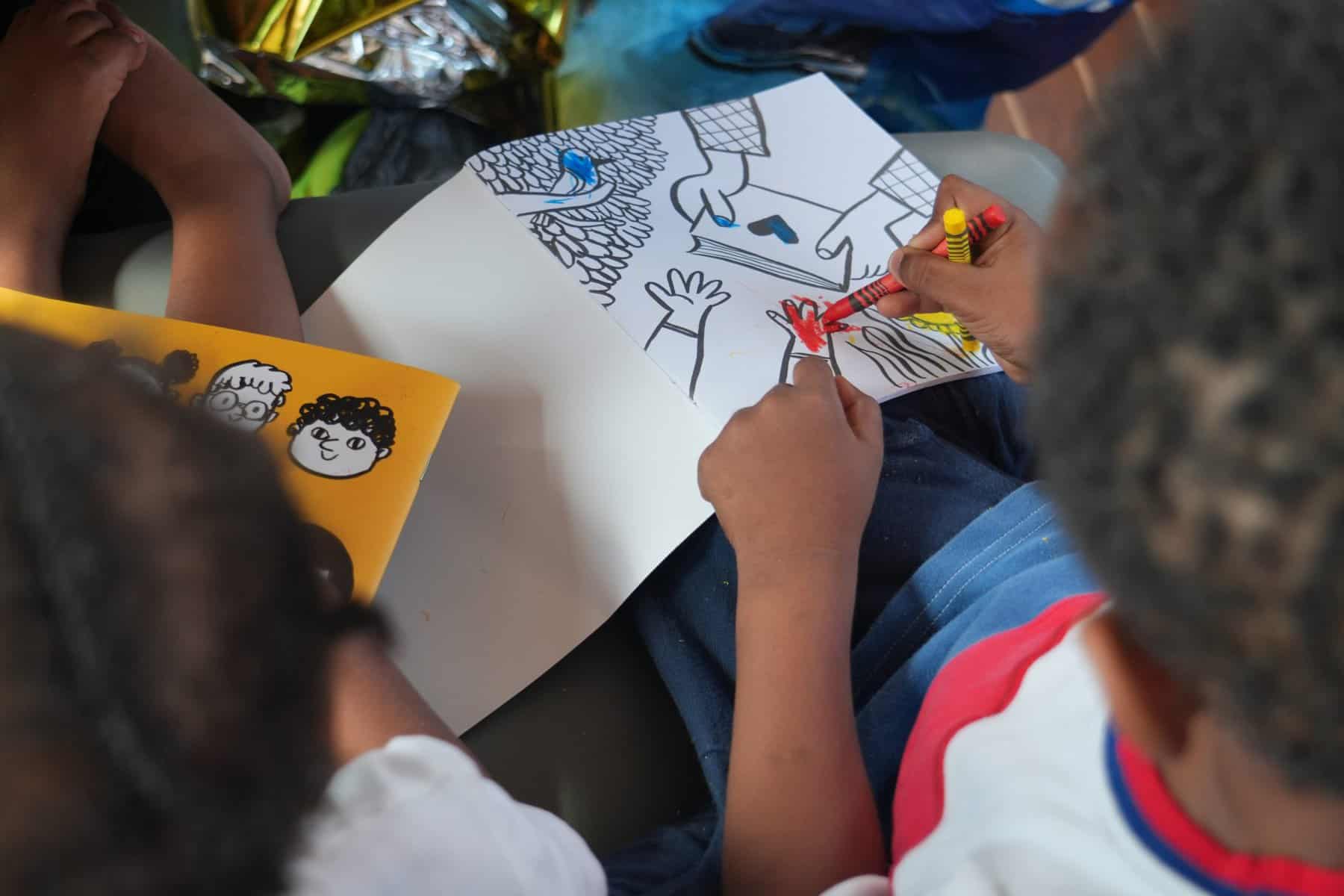
On Saturday afternoon, shortly after entering Italian waters, 14 people were transferred to an Italian Coast Guard vessel due to critical medical conditions. Hours later, the NADIR arrived in Lampedusa as well, together with the remaining 54 survivors and the three deceased. A large contingent of authorities, press, and humanitarian allies awaited us in the darkness. We ensured that the survivors could disembark in an orderly manner and wished them well for their onward journey, which is likely far from over.
The next day, together with others touched by the family’s tragic loss, we took a moment of silence. We lit candles and paused to keep the sisters and their loved ones in our thoughts, as they must now carry this loss and pain which could have been prevented if politics would take action.
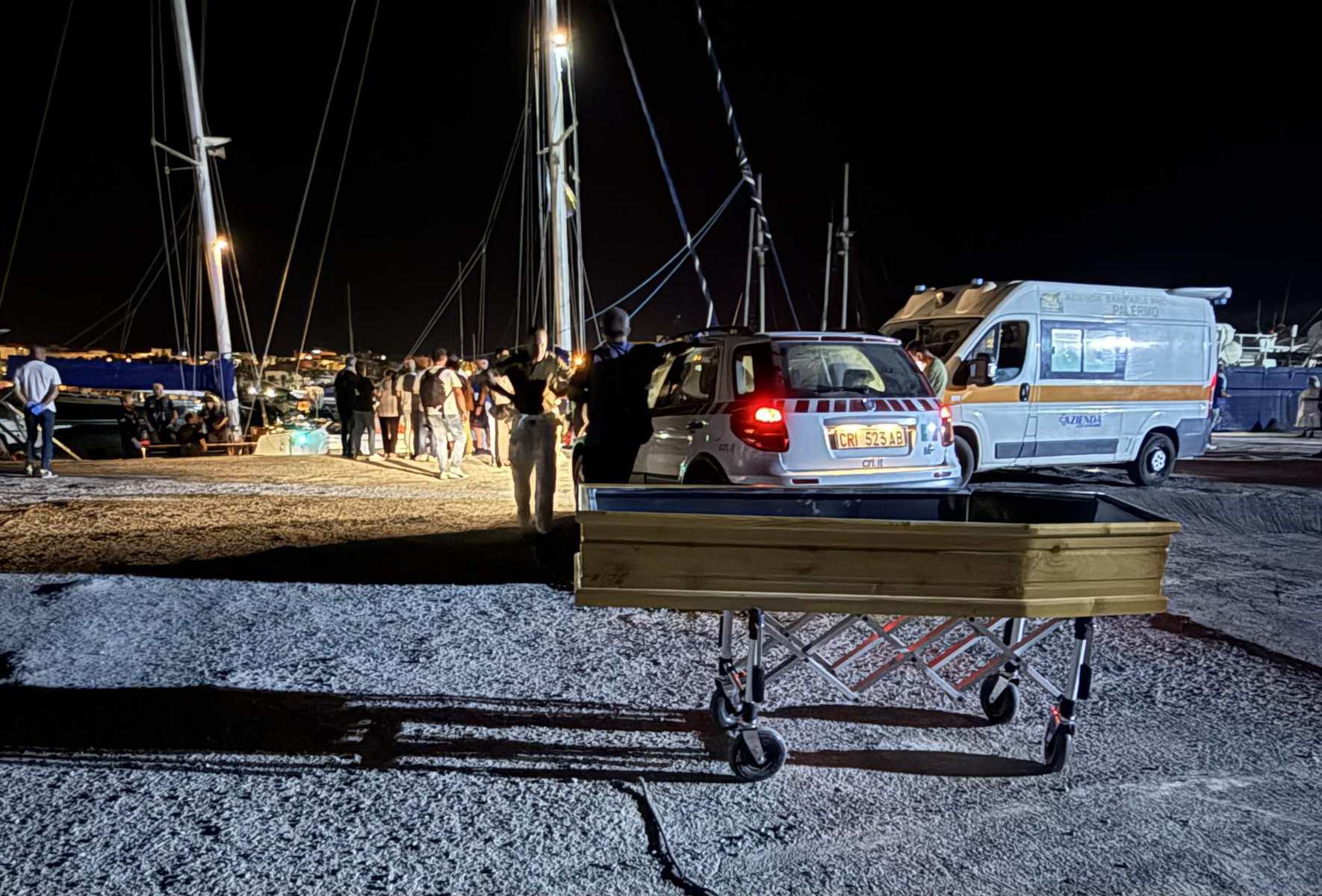
THE ITALIAN COAST GUARD ASKS FOR OUR HELP
Our time in Lampedusa was marked by talks with Italian authorities, completing formalities, and preparing the ship to head out again – for the very purpose that had brought us all here. On the evening of Monday, 25 August, 2025, we once again set sail, unaware that less than 24 hours later we would be ordered back to Lampedusa again.
Overnight, we returned to the operational area near the Kerkennah Islands in international waters. The next morning, we received a Mayday relay via radio from a Tunisian fishing boat that had spotted an overcrowded wooden vessel with multiple decks and around 130 people on board. Both the NADIR and the ASTRAL of the organization Open Arms were nearby and set course toward the distress case. The ASTRAL reached the distress site first. We stayed on stand-by, ready to assist, when the ASTRAL informed us of a second distress case nearby.
With our tender going in front we headed out toward an overcrowded rubber boat about four nautical miles away, where 58 people, including women and young children, in need of immediate help. They had been at sea for three days and were accordingly dehydrated. We quickly distributed life jackets and stabilized the situation. Shortly afterward, an Italian Coast Guard vessel arrived. After assessing the situation, they requested our assistance. With our tender, we were to transfer small children and injured individuals onto their ship. Working together, the operation succeeded smoothly. The remaining people were then safely transferred by securing the rubber boat alongside the Coast Guard vessel with our tender.
Although the Italian authorities had coordinated the rescue and evacuation, the NADIR was subsequently ordered to Lampedusa to personally deliver a special report on the incident. That this meant unnecessary travel to hand over a few pages of paperwork leaves little room for doubt: It was a deliberate obstruction of our operation by bureaucratic trivialities. This is a procedure not only we, but many other humanitarian NGOs, constantly have to face during our work in the central mediterranean.
After our third visit to Lampedusa, we once again returned to the operational area before our mission officially ended. Back in our home port, we prepared everything for the handover of the NADIR to the eighth crew of 2025. An exhausting but also fulfilling time came to an end.
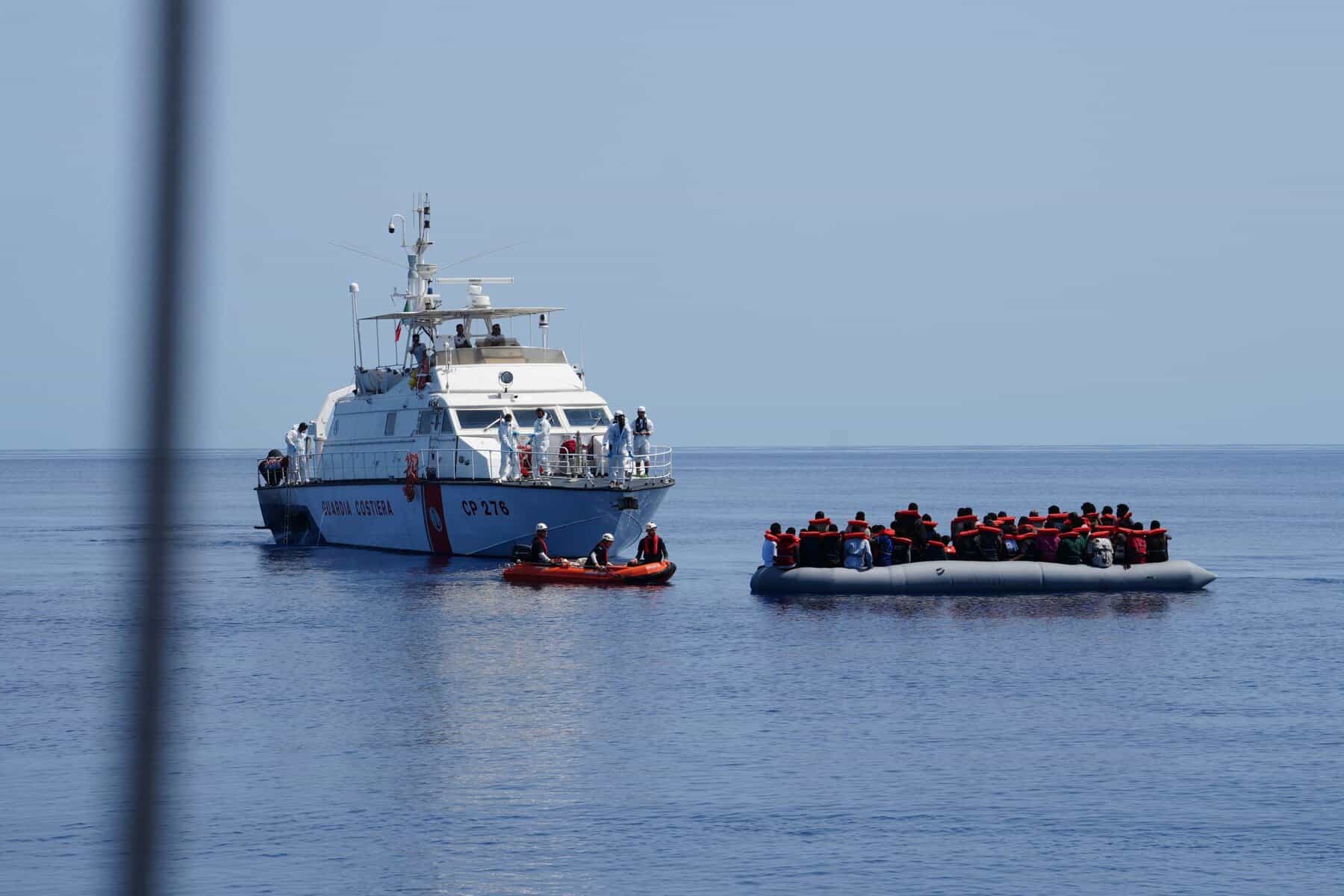
At the end of our mission, we can look back on encounters with over 140 people we were able to support on their journey. Alongside the joy for every single person we helped, we must also mourn the deaths of three far-too-young lives. The lives of three sisters whose families will have to carry this pain forever. We must remember that behind every number lies an individual story. And that what we experienced during these nearly three weeks at sea is only a small excerpt. For over a decade, such tragedies have repeated themselves again and again. However, we remain strong. We remain in solidarity. We remain where we are needed, to make a difference.
Photo credits: Barbara Sartore, Lars Wichmann, Jan Salmen | RESQSHIP
